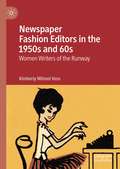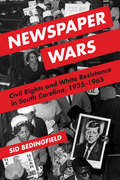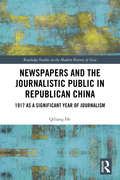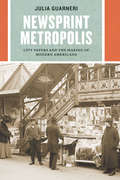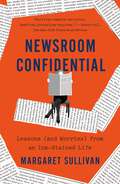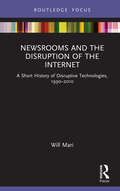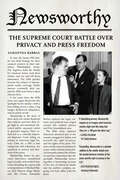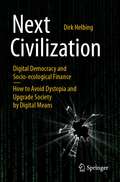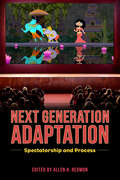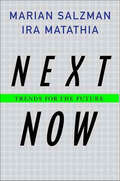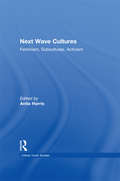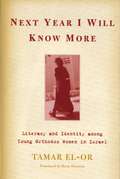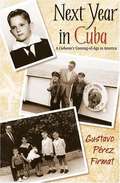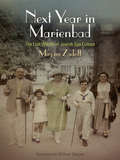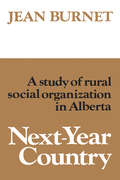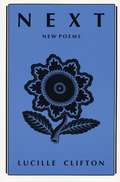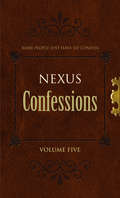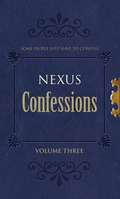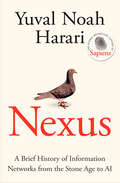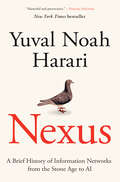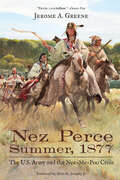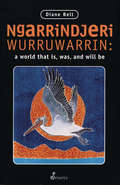- Table View
- List View
Newspaper Fashion Editors in the 1950s and 60s: Women Writers of the Runway
by Kimberly Wilmot VossThis book documents the careers of newspaper fashion editors and details what the fashion sections included in the post-World War II years. The analysis covers social, political and economic aspects of fashion. It also addresses journalism ethics, fashion show reporting and the decline in fashion journalism editor positions.
Newspaper Journalism (Journalism Studies: Key Texts)
by Peter Cole Tony HarcupAre newspapers faced with an existential threat or are they changing to meet the challenges of a digital world? With the newspaper's role in a state of fundamental redefinition, Newspaper Journalism offers a timely and up to the minute analysis of newspapers today, in the context of their historical importance to society. Drawing on their extensive experience in academia and also across local, national, mainstream and alternative newspapers, Cole and Harcup write clearly and engagingly from both industry and scholarly perspectives, and contend that, far from dying, newspapers are doing what they have always done: adapting to a changing environment. This text is essential reading for all students of the press, with comprehensive and critical coverage of the most important debates in the study of newspaper journalism - from ethics and investigative journalism to political economy and the future of the industry. Given the shifting boundaries and central importance of newspapers, it will be of interest to all students of journalism and the media. Praise for the Journalism Studies: Key Texts series: 'It is easy to describe a good textbook for a specific journalistic format... The ideal book has to satisfy a list of requirements that are also bullet-pointed in journalism assignment outlines. A text has to: synthesize the existing body of knowledge; explain concepts clearly; have a logical order of topics; and provide enough information and directions to pursue further study. One may also hope it would include real life examples and be lucid, vivid and a pleasure to read. Hard to find? Not anymore. The new SAGE series Journalism Studies: Key Texts satisfies the main requirements on the list. Carefully planned and meticulously edited by Martin Conboy, David Finkelstein and Bob Franklin, the textbook series is a welcome contribution to the literature of journalism studies... All three books follow the same structural template: an overview of historical development; explication of the political and economic frameworks within particular types of journalism; a review of contemporary practices; social demographics; a comparative analysis of practices around the world; a summary of main conceptual approaches; an indication of future directions; recommendations for further reading. This strong organization resembles a template for a course outline. This is intentional because the series is aimed both at students and their practice-based lecturers, who often come straight from industry and need time to adjust to the academic environment... [The series] achieves its aim to bridge the sometimes too evident dissonance between journalism theory and practice... They successfully situate discussions about journalism in social and historical contexts. We see the faces of individual journalists, the circumstances of news production, the relationship with owners, the battle between the public service and the profit nature of news, the relevance of journalism work. The detailed account of the conditions under which newspaper, radio and alternative journalism is produced and performed make the Journalism Studies: Key Texts series mandatory reading for both journalism students and their lecturers' - Verica Rupar, Journalism Studies
Newspaper Wars: Civil Rights and White Resistance in South Carolina, 1935-1965
by Sid BedingfieldAgainst all odds, the seeds of social change found purchase in mid-twentieth century South Carolina. Newspaperman John McCray and his allies at the Lighthouse and Informer challenged readers to "rebel and fight"--to reject the "slavery of thought and action" and become "progressive fighters" for equality. Newspaper Wars traces the role journalism played in the fight for civil rights in South Carolina from the 1930s through the 1960s. Moving the press to the center of the political action, Sid Bedingfield tells the stories of the long-overlooked men and women on the front lines of a revolution. African American progress sparked a battle to shape South Carolina's civic life, with civil rights activists arrayed against white journalists determined to preserve segregation through massive resistance. As that strategy failed, white newspapers turned to overt political action and crafted the still-prevalent narratives that aligned southern whites with the national conservative movement. A fascinating portrait of a defining time, Newspaper Wars analyzes the role journalism played--and still can play--during times of social, cultural, and political change.
Newspapers and the Journalistic Public in Republican China: 1917 as a Significant Year of Journalism (Routledge Studies in the Modern History of Asia)
by Qiliang HeOffering an entirely new approach to understanding China’s journalism history, this book covers the Chinese periodical press in the first half of the twentieth century. By focusing on five cases, either occurring in or in relation to the year 1917, this book emphasizes the protean nature of the newspaper and seeks to challenge a press historiography which suggests modern Chinese newspapers were produced and consumed with clear agendas of popularizing enlightenment, modernist, and revolutionary concepts. Instead, this book contends that such a historiography, which is premised on the classification of newspapers along the lines of their functions, overlooks the opaqueness of the Chinese press in the early twentieth century. Analyzing modern Chinese history through the lens of the newspaper, this book presents an interdisciplinary and international approach to studying mass communications. As such, this book will be useful to students and scholars of Chinese history, journalism, and Asian Studies more generally.
Newsprint Metropolis: City Papers and the Making of Modern Americans
by Julia GuarneriAt the close of the nineteenth century, new printing and paper technologies fueled an expansion of the newspaper business. Newspapers soon saturated the United States, especially its cities, which were often home to more than a dozen dailies apiece. Using New York, Philadelphia, Milwaukee, and Chicago as case studies, Julia Guarneri shows how city papers became active agents in creating metropolitan spaces and distinctive urban cultures. Newsprint Metropolis offers a vivid tour of these papers, from the front to the back pages. Paying attention to much-loved features, including comic strips, sports pages, advice columns, and Sunday magazines, she tells the linked histories of newspapers and of the cities they served. Guarneri shows how themed sections for women, businessmen, sports fans, and suburbanites illustrated entire ways of life built around consumer products. But while papers provided a guide to individual upward mobility, they also fostered a climate of civic concern and responsibility. Charity campaigns and metropolitan sections painted portraits of distinctive, cohesive urban communities. Real estate sections and classified ads boosted the profile of the suburbs, expanding metropolitan areas while maintaining cities’ roles as economic and information hubs. All the while, editors were drawing in new reading audiences—women, immigrants, and working-class readers—helping to give rise to the diverse, contentious, and commercial public sphere of the twentieth century.
Newsroom Confidential: Lessons (and Worries) from an Ink-Stained Life
by Margaret Sullivan"Sullivan remains the critic American journalism requires, a veteran practitioner with street cred, still in touch with the ‘unaccountable joy’ of reporting and writing that continues to draw talented young people to the field.” —Steve Coll, The New York Times Book ReviewSullivan began her career at the Buffalo News, where she rose from summer intern to editor in chief. In Newsroom Confidential she chronicles her years in the trenches battling sexism and throwing elbows in a highly competitive newsroom. In 2012, Sullivan was appointed the public editor of The New York Times, the first woman to hold that important role. She was in the unique position of acting on behalf of readers to weigh the actions and reporting of the paper's staff, parsing potential lapses in judgment, unethical practices, and thorny journalistic issues. Sullivan recounts how she navigated the paper’s controversies, from Hillary Clinton's emails to Elon Musk's accusations of unfairness to the need for greater diversity in the newsroom. In 2016, having served the longest tenure of any public editor, Sullivan left for the Washington Post, where she had a front-row seat to the rise of Donald Trump in American media and politics.With her celebrated mixture of charm, sharp-eyed observation, and nuanced criticism, Sullivan takes us behind the scenes of the nation's most influential news outlets to explore how Americans lost trust in the news and what it will take to regain it.
Newsrooms and the Disruption of the Internet: A Short History of Disruptive Technologies, 1990–2010 (Disruptions)
by Will MariNewsrooms and the Disruption of the Internet is an insightful account of what happened when the internet first arrived in the 1990s and early 2000s in the recently computerized, but still largely unchanged, newspaper industry. Providing a focused narrative of how the internet disrupted news collection, editing, presentation and dissemination, the book examines the role of the internet from helpful adjunct to extension to, eventually, successor to the traditional print product. Experiments by large national newspaper “brands” and other first-adopters in the 1990s are described, tracing the slow adoption of the internet by chains and large metro papers, followed by the smaller daily and weekly newspapers by the early 2000s. The book describes the changes that arrived as more “Web 2.0” technologies become prevalent and as social media shifted the news-media landscape in the mid-to-late 2000s, ultimately changing how most people in the West consumed and thought of “the news”. This book is intended for academics and researchers in the fields of journalism studies, history of technology, and media studies, especially those interested in transitions from analogue to digital technology, and the initial adoption of the commercial internet.
Newsworthy: The Supreme Court Battle over Privacy and Press Freedom
by Samantha BarbasIn 1952, the Hill family was held hostage by escaped convicts in their suburban Pennsylvania home. The family of seven was trapped for nineteen hours by three fugitives who treated them politely, took their clothes and car, and left them unharmed. The Hills quickly became the subject of international media coverage. Public interest eventually died out, and the Hills went back to their ordinary, obscure lives. Until, a few years later, the Hills were once again unwillingly thrust into the spotlight by the media—with a best-selling novel loosely based on their ordeal, a play, a big-budget Hollywood adaptation starring Humphrey Bogart, and an article in Life magazine. Newsworthy is the story of their story, the media firestorm that ensued, and their legal fight to end unwanted, embarrassing, distorted public exposure that ended in personal tragedy. This story led to an important 1967 Supreme Court decision—Time, Inc. v. Hill—that still influences our approach to privacy and freedom of the press. Newsworthy draws on personal interviews, unexplored legal records, and archival material, including the papers and correspondence of Richard Nixon (who, prior to his presidency, was a Wall Street lawyer and argued the Hill family's case before the Supreme Court), Leonard Garment, Joseph Hayes, Earl Warren, Hugo Black, William Douglas, and Abe Fortas. Samantha Barbas explores the legal, cultural, and political wars waged around this seminal privacy and First Amendment case. This is a story of how American law and culture struggled to define and reconcile the right of privacy and the rights of the press at a critical point in history—when the news media were at the peak of their authority and when cultural and political exigencies pushed free expression rights to the forefront of social debate. Newsworthy weaves together a fascinating account of the rise of big media in America and the public's complex, ongoing love-hate affair with the press.
Next Civilization: Digital Democracy and Socio-Ecological Finance - How to Avoid Dystopia and Upgrade Society by Digital Means
by Dirk Helbing"Digital transformation" sounds harmless, given that the explosion in data volumes, processing power and Artificial Intelligence has driven humanity and the entire world to a point of no return. We will surely see a new civilization, but we are at a crossroads. The future needs to be re-invented, decisions must be taken. After the automation of factories and the creation of self-driving cars, the automation of society is on its way. But there are two kinds of automation: a centralized top-down control of the world and a distributed control approach, supporting local self-organization. Using the power of today’s information systems, governments and big tech companies seem to engage in the first approach. Might they even build a „digital Crystal Ball“ that knows almost everything, including your personality, and a super-intelligent "digital God“ to control what we do? We are much closer to such „science fiction scenarios“ than you probably think. In this much expanded second edition of "The Automation of Society is Next: How to Survive the Digital Revolution" (2015), the author discusses lessons learned on digital democracy, aspects of transhumanism and far-reaching thoughts about life in the digital age and what it may mean to be human in the future.
Next Generation Adaptation: Spectatorship and Process
by Allen H. RedmonContributions by Zoe Bursztajn-Illingworth, Marc DiPaolo, Emine Akkülah Doğan, Caroline Eades, Noelle Hedgcock, Tina Olsin Lent, Rashmila Maiti, Allen H. Redmon, Jack Ryan, Larry T. Shillock, Richard Vela, and Geoffrey Wilson In Next Generation Adaptation: Spectatorship and Process, editor Allen H. Redmon brings together eleven essays from a range of voices in adaptation studies. This anthology explores the political and ethical contexts of specific adaptations and, by extension, the act of adaptation itself. Grounded in questions of gender, genre, and race, these investigations focus on the ways attention to these categories renegotiates the rules of power, privilege, and principle that shape the contexts that seemingly produce and reproduce them. Contributors to the volume examine such adaptations as Quentin Tarantino’s Death Proof, Jacques Tourneur’s Out of the Past, Taylor Sheridan’s Sicario and Sicario: Day of the Soldado, Jean-Jacques Annaud’s Wolf Totem, Spike Lee’s He’s Got Game, and Jim Jarmusch’s Paterson. Each chapter considers the expansive dialogue adaptations accelerate when they realize their capacity to bring together two or more texts, two or more peoples, two or more ideologies without allowing one expression to erase another. Building on the growing trends in adaptation studies, these essays explore the ways filmic texts experienced as adaptations highlight ethical or political concerns and argue that spectators are empowered to explore implications being raised by the adaptations.
Next Now: Trends for the Future
by Marian Salzman Ira MatathiaFrom the world-renowned trendspotting duo who has predicted everything from metrosexuality to the growth of global brands comes a new, enlightening look at the future. Based on intensive research and interviews as well as the authors' real-world and business experience in locations across the globe, this book yields surprising conclusions about everything from work (the end of permanent full-time employment) to sex (disappearing gender boundaries) to business (the emergence of true one-to-one marketing and the birth of "Chindia"). Essential reading for managers, marketers, and just about everyone else.
Next Steps in Supporting People with Autistic Spectrum Condition
by John Simpson Sue HattonIf you work with people with autistic spectrum condition and are studying for a health and social care qualification, or you want the right information to help your personal development, then Next steps in supporting people with autistic spectrum condition is for you. This book puts the person with autism at the centre of the support you give. It uses real life stories, activities and thinking points to cover all of the learning outcomes and it is full of practical examples of how to apply the ideas to the support you provide.
Next Wave Cultures: Feminism, Subcultures, Activism (Critical Youth Studies)
by Anita HarrisWhereas once young women’s feminist activism could be easily identified, today this resistance seems obscure, transitory, and disorganized. In Next Wave Cultures, established and emerging scholars provide an interdisciplinary examination of young women’s multilayered lives. This collection demonstrates that young women have new ways of taking on politics and culture that may not be recognizable under more traditional paradigms, but deserve to be identified as socially engaged and potentially transformative nonetheless. Exploring the ways in which girls' various cultural pursuits are tied to identity formation and relate to issues of class, sexuality, ethnicity, religion, ability, and, gender, Next Wave Cultures highlights both the limitations and opportunities afforded by globalization of youth consumer culture. This valuable collection is a necessary read across disciplines—especially to those in the fields of education, gender and cultural studies, sociology, and psychology.
Next Year I Will Know More: Literacy and Identity among Young Orthodox Women in Israel
by Haim Watzman Tamar El-OrIn traditional Jewish societies of previous centuries, literacy education was mostly a male prerogative. Even more recently, women have not been taught the traditional male curriculum that includes the Talmud and midrashic books. But the situation is changing, partly because of the special emphasis that modern Judaism places on learning its philosophy and traditions and on broadening its circle of knowers. In Next Year I Will Know More, the distinguished Israeli anthropologist Tamar El-Or explores the spreading practice of intensive Judaic studies among women in the religious Zionist community. Feminist literacy, notes El-Or, will alter gender relations and the construction of gender identities of the members of the religious community. This in turn could effect changes in Jewish theology and law. In an engaging narrative that offers rare insights into a traditional society in the midst of a modern world, the author points to a community that will be more feminist--and even more religious.
Next Year in Cuba: A Cubano's Coming-of-Age in America
by Gustavo Pérez FirmatThis is a personal account of a young Cuban's departure from his native country and his assimilation of American culture and values, including marriage to an American, raising an American family, teaching at an American university....
Next Year in Marienbad
by Mirjam Zadoff William TemplerFrom the last decades of the nineteenth century through the late 1930s, the West Bohemian spa towns of Carlsbad, Franzensbad, and Marienbad were fashionable destinations for visitors wishing to "take a cure"--to drink the waters, bathe in the mud, be treated by the latest X-ray, light, or gas therapies, or simply enjoy the respite afforded by elegant parks and comfortable lodgings. These were sociable and urbane places, settings for celebrity sightings, match-making, and stylish promenading. Originally the haunt of aristocrats, the spa towns came to be the favored summer resorts for the emerging bourgeoisie. Among the many who traveled there, a very high proportion were Jewish.In Next Year in Marienbad, Mirjam Zadoff writes the social and cultural history of Carlsbad, Franzensbad, and Marienbad as Jewish spaces. Secular and religious Jews from diverse national, cultural, and social backgrounds mingled in idyllic and often apolitical-seeming surroundings. During the season, shops sold Yiddish and Hebrew newspapers, kosher kitchens were opened, and theatrical presentations, concerts, and public readings catered to the Jewish clientele. Yet these same resorts were situated in a region of growing hostile nationalisms, and they were towns that might turn virulently anti-Semitic in the off season.Next Year in Marienbad draws from memoirs and letters, newspapers and maps, novels and postcards to create a compelling and engaging portrait of Jewish presence and cultural production in the years between the fin de siècle and the Second World War.
Next of Kin: The Family in Chicano/a Cultural Politics
by Richard T. RodriguezAs both an idea and an institution, the family has been at the heart of Chicano/a cultural politics since the Mexican American civil rights movement emerged in the late 1960s.
Next-Year Country: A Study of Rural Social Organization in Alberta (Social Credit in Alberta #3)
by Jean BurnetIn this study of the problems of social organization in a rural community of Alberta, a drought-afflicted wheat-growing area centring round the town of Hanna is described as it appeared to the sociologist in 1946.Dr Burnet examines geographical and economic conditions in Hanna, and shows how farming practices, ways of living, and modes of tenure brought into the area from more humid regions proved ill adapted to the dry belt and delayed economic adjustment. In turn, the difficulties in the realm of economics had adverse social and cultural consequences in both the households and the community as a whole.The Hanna area was chosen for study, though not altogether typical, because it revealed more clearly than other areas not so severely hit by the drought of the 1930s the kind of disturbances within the Alberta social structure which made possible the rise of the Social Credit movement.
Next: New Poems (American Poets Continuum #15.00)
by Lucille CliftonFinalist, 1988 Pulitzer Prize for Poetry. "Clifton mythologizes herself: that is, she illuminated her surroundings and history from within in a way that casts light on much beyond."--The Women's Review of Books
Nexus Confessions: Volume Five (Nexus Confessions #5)
by VariousNexus Confesions - true erotic stories from real-life fetish enthusiasts...Swinging, dogging, group sex, cross-dressing, spanking, female domination, corporal punishment, and extreme fetishes...Nexus Confessions explores the length and breadth of erotic obsession, real experience and sexual fantasy. This is an encyclopaedic collection of the bizarre, the extreme, the utterly inappropriate, the daring and the shocking experiences of ordinary men and women driven by their extraordinary desires. Collected by the world's leading publisher of fetish fiction, this is the fifth in a series of six volumes of true stories and shameful confessions, never-before-told or published.
Nexus Confessions: Volume Three (Nexus Confessions #3)
by VariousNexus Confessions - true life erotic stories from fetish enthusiasts...Nexus Confessions explores the length and breadth of erotic obsession, real experience and sexual fantasy. This is an encyclopaedic collection of the bizarre, the extreme, the utterly inappropriate, the daring and the shocking experiences of ordinary men and women driven by their extraordinary desires. Collected by the world's leading publisher of fetish fiction, this is the third in a series of six volumes of true stories and shameful confessions, never-before-told or published.
Nexus: A Brief History of Information Networks from the Stone Age to AI
by Yuval Noah HarariFrom the #1 New York Times bestselling author of Sapiens comes the groundbreaking story of how information networks have made, and unmade, our world.For the last 100,000 years, we Sapiens have accumulated enormous power. But despite all our discoveries, inventions, and conquests, we now find ourselves in an existential crisis. The world is on the verge of ecological collapse. Misinformation abounds. And we are rushing headlong into the age of AI—a new information network that threatens to annihilate us. For all that we have accomplished, why are we so self-destructive?Nexus looks through the long lens of human history to consider how the flow of information has shaped us and our world. Taking us from the Stone Age, through the canonization of the Bible, early modern witch hunts, Stalinism, Nazism, and the resurgence of populism today, Yuval Noah Harari asks us to consider the complex relationship between information and truth, bureaucracy and mythology, wisdom and power. He explores how different societies and political systems throughout history have wielded information to achieve their goals, for good and ill. And he addresses the urgent choices we face as non-human intelligence threatens our very existence.Information is not the raw material of truth, nor is it a mere weapon. Nexus explores the hopeful middle ground between these extremes, and in doing so, rediscovers our shared humanity.
Nexus: A Brief History of Information Networks from the Stone Age to AI
by Yuval Noah Harari#1 NEW YORK TIMES BESTSELLER • From the author of Sapiens comes the groundbreaking story of how information networks have made, and unmade, our world.&“Strikingly original . . . A historian whose arguments operate on the scale of millennia has managed to capture the zeitgeist perfectly.&”—The Economist&“This deeply important book comes at a critical time as we all think through the implications of AI and automated content production. . . . Masterful and provocative.&”—Mustafa Suleyman, author of The Coming WaveFor the last 100,000 years, we Sapiens have accumulated enormous power. But despite all our discoveries, inventions, and conquests, we now find ourselves in an existential crisis. The world is on the verge of ecological collapse. Misinformation abounds. And we are rushing headlong into the age of AI—a new information network that threatens to annihilate us. For all that we have accomplished, why are we so self-destructive?Nexus looks through the long lens of human history to consider how the flow of information has shaped us, and our world. Taking us from the Stone Age, through the canonization of the Bible, early modern witch-hunts, Stalinism, Nazism, and the resurgence of populism today, Yuval Noah Harari asks us to consider the complex relationship between information and truth, bureaucracy and mythology, wisdom and power. He explores how different societies and political systems throughout history have wielded information to achieve their goals, for good and ill. And he addresses the urgent choices we face as non-human intelligence threatens our very existence.Information is not the raw material of truth; neither is it a mere weapon. Nexus explores the hopeful middle ground between these extremes, and in doing so, rediscovers our shared humanity.
Nez Perce Summer, 1877: The U.S. Army and the Nee-Me-Poo Crisis
by Jerome A. GreeneNez Perce Summer, 1877 tells the story of a people&’s epic struggle to survive spiritually, culturally, and physically in the face of unrelenting military force. Written by one of the foremost experts in frontier military history, Jerome A. Greene, and reviewed by members of the Nez Perce tribe, this definitive treatment of the Nez Perce War is the first to incorporate research from all known accounts of Nez Perce and U.S. military participants. Enhanced by sixteen detailed maps and forty-nine historic photographs, Greene&’s gripping narrative takes readers on a three-and-one-half month 1,700-mile journey across the wilds of Idaho, Wyoming, and Montana territories. All of the skirmishes and battles of the war receive detailed treatment, which benefits from Greene&’s astute analysis of the strategies and decision making on both sides. Between 100 and 150 of the more than 800 Nez Perce men, women, and children who began the trek were killed during the war. Almost as many died in the months following the surrender, after they were exiled to malaria-ridden northeastern Oklahoma. Army deaths numbered 113. The casualties on both sides were an extraordinary price for a war that nobody wanted but whose history has since fascinated generations of Americans.
Ngarrindjeri Wurruwarrin
by Diane BellThis finely textured ethnography weaves written texts with the voices of women and men who struggle to protect their sacred sites. It provides a deeper understanding of lives profoundly affected by two centuries of colonization.
